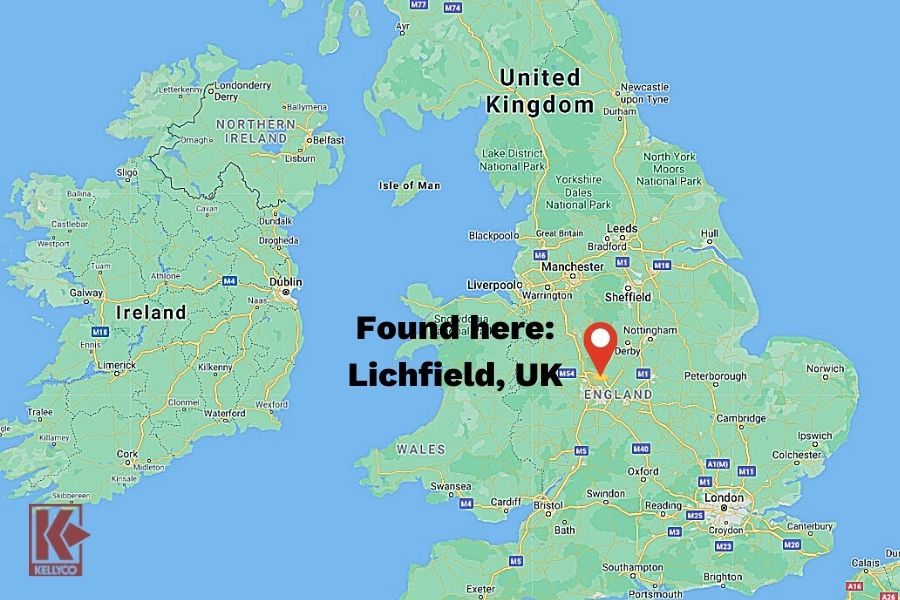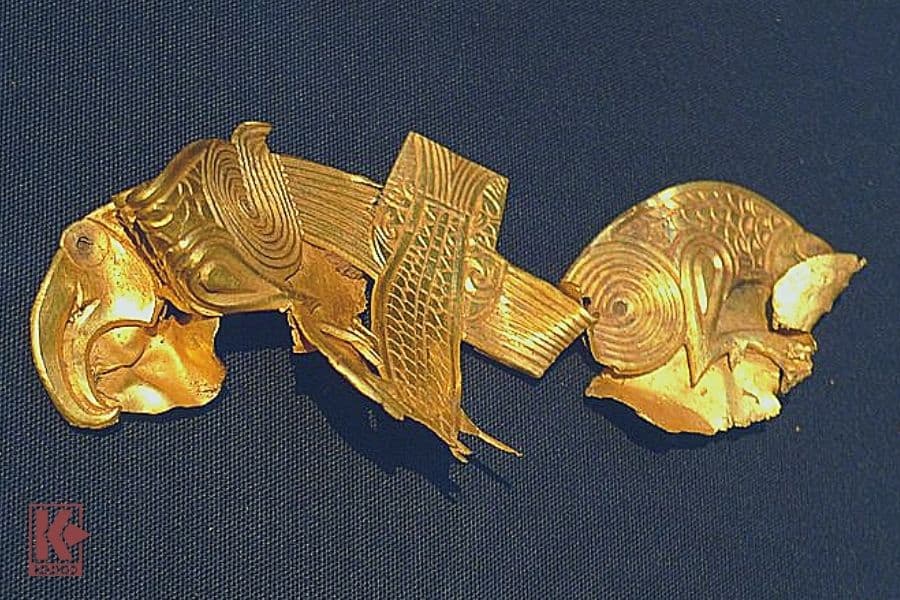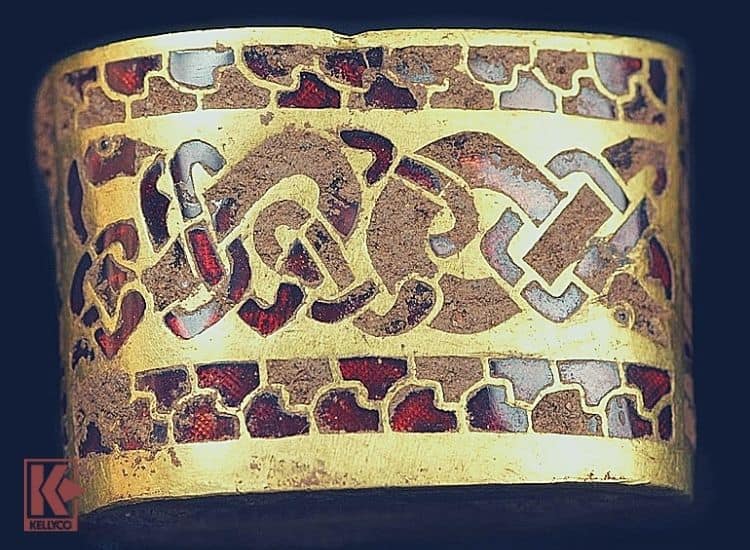The Staffordshire Hoard: The Largest Hoard of Anglo-Saxon Metalwork
Published by Sam Jacobs on 03/05/21

Staffordshire Hoard found in Lichfield, UK
The Anglo-Saxons were and are renowned for their metalwork. This is not the crude metallurgy of an uncultivated barbarian horde, but the beautiful design work in the noble metals of silver and gold that only a truly cultured people could produce. Nowhere is this exemplified more than with the Staffordshire Hoard, the largest hoard of Anglo-Saxon metalwork ever uncovered, even larger than the famous Sutton Hoo Hoard.
First, let’s talk about the tale of the tape: The Staffordshire Hoard includes 11 pounds of gold (5.1 kg), three pounds of silver, and over 3,500 pieces of garnet cloisonné jewelry. Manufactured during the 6th and 7th Centuries, it was most likely buried in the 7th, but like so many relics of the ancient world, it was uncovered a little closer to where we live — in 2009.
More than simply the value of the riches in this Hoard, there is the small matter of what this means for Anglo-Saxon archaeology and scholarship. None of the goods belong to women. Nearly all are martial in nature, the exception being three religious items. Thus, archaeologists now have an incredibly clear snapshot of Anglo-Saxon physical culture. The Hoard revealed that the Anglo-Saxons had perfected a technique known as depletion gilding that gives the surface of an object the appearance of being a higher purity of gold than it actually is. Some of the pieces are thought to have come from as far away as Sri Lanka and Afghanistan, but these likely date back to the Roman Era.
The Hoard itself is thought to be what is somewhat awesomely called a “war hoard.” What this means is that archaeologists suspect that the bulk or even the entirety of the hoard was captured by Anglo-Saxon warriors from the Kingdom of Mercia in the battle against the Northumbrians and East Anglians.

Sheet Gold Plaque, Staffordshire Hoard
Fully 80 percent of what was found belonged to weaponry. This is one of the reasons it was such an archaeologically interesting find. Gold sword pommels are rare in the extreme, with merely one being found in the entire Sutton Hoo Hoard. By contrast, the Staffordshire Hoard boasted as many as 50 of these. What this allowed archaeologists to conclude was that, as opposed to many other cultures, they were not rare among the Mercians. It was common for such finery to only belong to a king, but for the Mercians, it seems to have been a common item for the entire warrior class.
King Penda of Mercia is the most likely “owner” of the Hoard. But sadly, there is nothing on the Hoard that specifies him as the royal owner of these goods. It’s simply a conclusion that has been drawn by the time period that the wares date from.
Perhaps one of the most fascinating aspects of the Staffordshire Hoard is how it was discovered. Terry Herbert, a member of Bloxwich Research and Metal Detecting Club, is the man who made the discovery. He was doing what he loved — hunting around with his metal detector — when he came upon the Hoard. Over the course of five days, Herbert unearthed 244 gold objects before contacting Duncan Slarke, the Finds Liaison Officer for the Staffordshire and West Midlands Portable Antiquities Scheme. The landowner then allowed for a total excavation of the Hoard.
Unlike the Hoxne Hoard, which was noteworthy due to how close together everything remained over the course of several centuries, the Staffordshire Hoard was all spread out from years of plowing the fields. A 30×43-foot area had to be carefully combed to find every last piece. The Home Office conducted a final sweep of the area using highly sophisticated geophysical equipment and concluded that everything had been unearthed.
The Hoard was put on display at the Birmingham Museum and Art Gallery before Birmingham Archaeology was even done processing it, attracting 40,000 visitors during its initial showing. A coroner’s inquest found that the find was a treasure, which made it the property of the Crown. However, in accordance with British statutes adopted after the unearthing of the Hoxne Hoard, there was a bounty paid out both to the man who discovered the Hoard, as well as the landowner.

A hilt fitting from the Staffordshire hoard, which was declared to be treasure in September 2009
There was an additional excavation in 2010, whose aim was not to find more treasure but to unearth archaeological evidence with an eye toward helping to date the items from the initial haul. A third excavation in 2012, however, found an additional 91 pieces. Most of these were small, but there were some larger pieces, including a large gold cross. Only 81 out of these pieces were declared to be treasures at the inquest.
The Treasure Valuation Committee put the value of the original Hoard at £3.2 million, or about $5.3 million in 2021 dollars. According to the 1996 Treasure Act, which was passed partly in response to the discovery of the Hoxne Hoard, this was to be split between the man who found it and the owner of the land on which it was found. The Birmingham Museum and Art Gallery and the Potteries Museum and Art Gallery declared their intention to jointly purchase the Hoard and a public appeal was made to raise the funds.
The money was split equally between the man who discovered the Hoard and the owner of the land. This apparently led to some discord between the two men, eventually resulting at the end of their friendship, but little about the details of this is known other than that each accuses the other of excessive greed when it comes to the proceeds from the discovery of the Hoard.
The Staffordshire Hoard is fascinating on virtually every level — how it was found, where it came from, the contents of the Hoard, and what happened to the men who benefited financially from its discovery. There are doubtless many treasures lurking around the world today, buried long ago that are simply waiting for someone with the right equipment to come along and discover them.
Images of the Straffordshire Hoard have been sourced from Wikimedia Commons.
